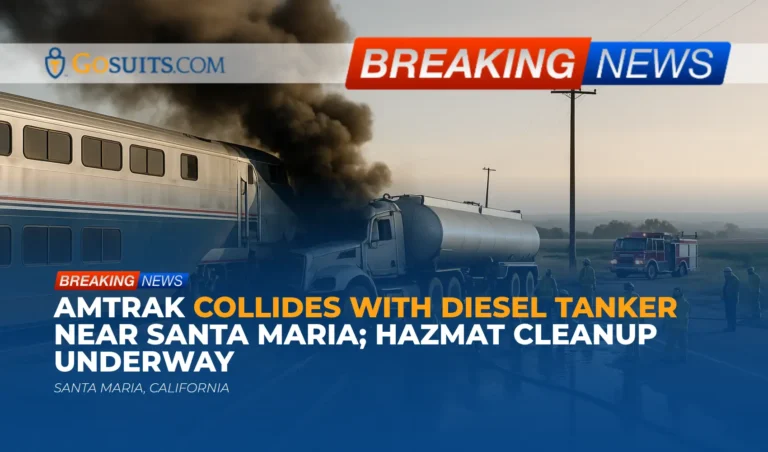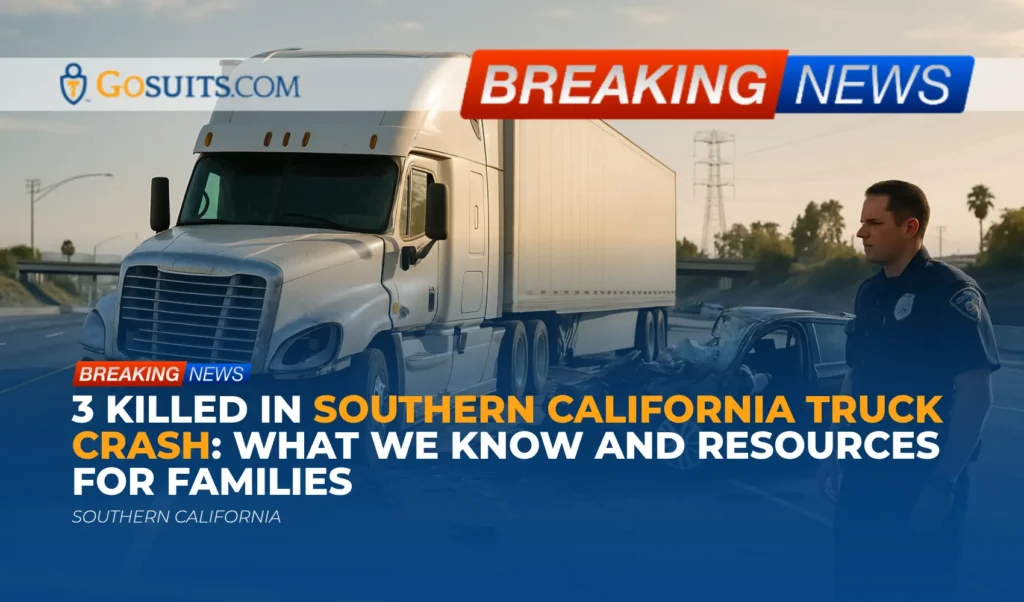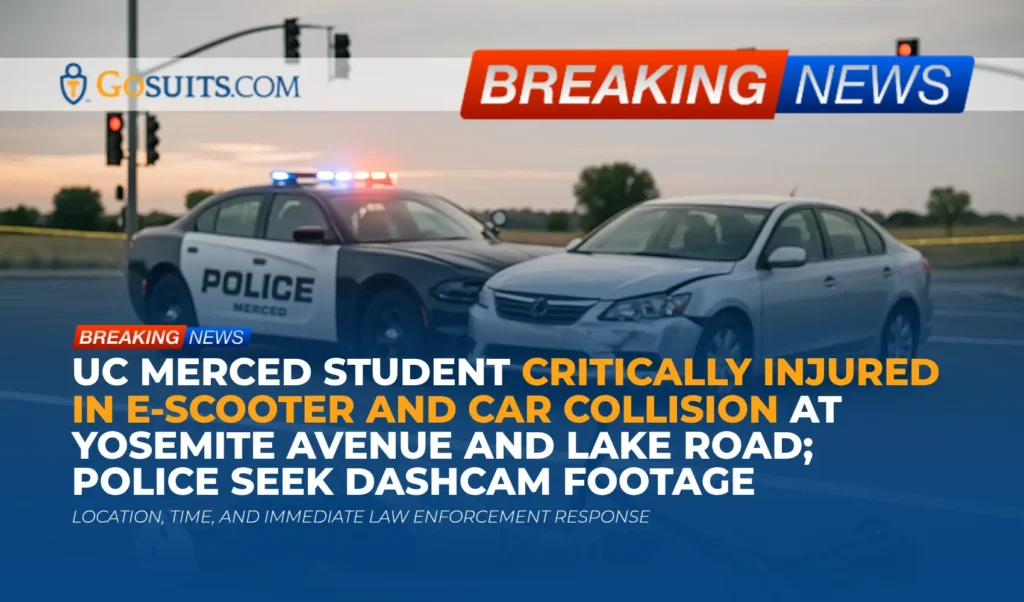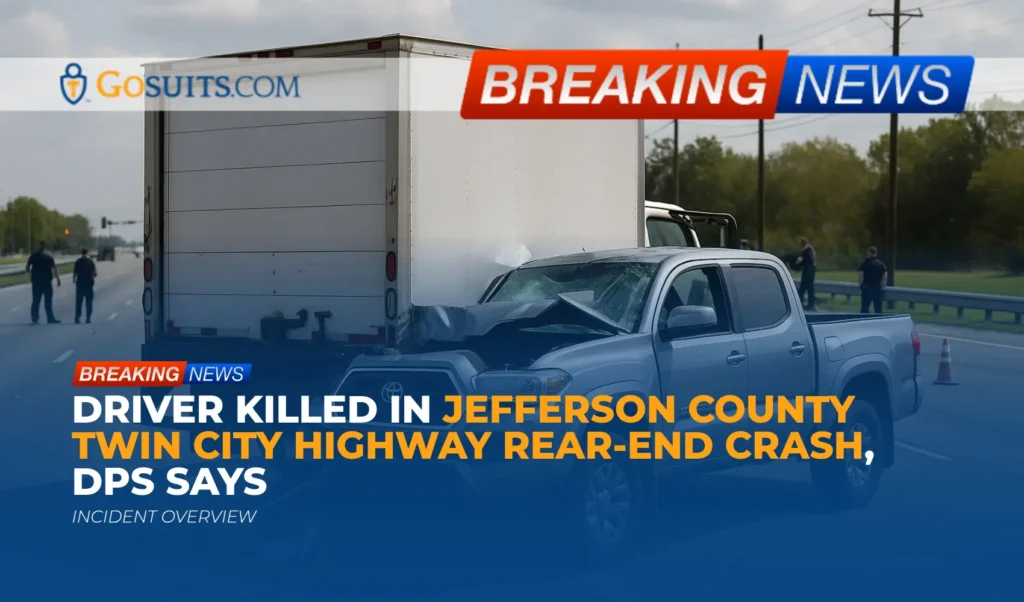Index
- Summary of the Incident
- Who Was Involved
- Where and When It Happened
- Immediate Emergency Response and Hazmat Handling
- Legal and Safety Issues Raised by This Collision
- Who Might Be Liable: Possible Civil Claims
- Evidence, Reports, and Records Families Should Obtain
- Practical Steps for Injured Passengers and Families (what to do now)
- Insurance and Claims — what to expect and how to proceed
- Reporting, Agencies, and Helpful Contacts
- Data & Context: Railroad grade crossing collisions (national & state context)
- Commentary from Gosuits Santa Maria, California Personal Injury Attorney
- Frequently Asked Questions (FAQs)
Summary of the Incident
On October 1, 2025, an Amtrak passenger train collided with a tanker truck hauling diesel fuel at a marked railroad crossing west of Santa Maria in Santa Barbara County, California. The crash was reported at about 4:15 p.m. Authorities said the train may have partially derailed but remained upright. Approximately 260 passengers were aboard. The tanker driver sustained major injuries and was transported to Marian Regional Medical Center; three passengers sustained minor injuries and were also transported to the hospital. About 3,500 gallons of diesel reportedly spilled onto the ground and tracks, prompting a hazardous materials response and temporary closure of Highway 1 in the area.
Who Was Involved
- Amtrak passenger train: approximately 260 passengers and crew aboard.
- Tanker truck: hauling diesel fuel; driver seriously injured.
- Emergency responders at scene: Santa Barbara County Fire Department, Guadalupe Fire, Santa Maria Fire, California Highway Patrol (CHP), American Medical Response (AMR), Caltrans, Santa Barbara County Sheriff’s Office, and Amtrak Police.
- Hazmat crews: dispatched to address the diesel fuel spill and environmental contamination.
(Information above is summarized from reported media coverage of the event.)
Where and When It Happened
- Location: Railroad crossing near Highway 1 and Brown Road, west of Santa Maria, Santa Barbara County, California. The crossing reportedly has a stop sign and signage that reads “Private RR crossing,” but does not have active crossing arms or flashing gates.
- Time and Date: Reported at about 4:15 p.m. on October 1, 2025. Highway 1 was shut down between Brown Road and Main Street/Highway 166 during emergency response.
Immediate Emergency Response and Hazmat Handling
- Medical response: Injured transported by AMR (American Medical Response) to local hospitals. The tanker driver had major injuries; three train passengers had minor injuries. Emergency medical triage and transport are typical priorities at such scenes.
- Fire and hazmat response: County and local fire departments responded and called hazardous materials teams to address the 3,500-gallon diesel spill. Diesel is combustible and can cause fire risk, environmental contamination, and health hazards if inhaled in concentrated fumes or if it contaminates groundwater or waterways. State and local environmental and emergency agencies coordinate spill response and cleanup.
- Traffic and rail operations: Highway 1 and train traffic in the immediate area were temporarily stopped while responders secured the scene, treated the injured, and managed the fuel spill.
Legal and Safety Issues Raised by This Collision
This collision raises several legal and public-safety questions families and passengers commonly ask after such events:
- Crossing safety and signage: The crossing was a marked crossing with a stop sign and a “Private RR crossing” sign, but without active warning devices (no lowering arms or flashing lights). Passive crossings like this increase reliance on motorists to look and stop for trains. The design and maintenance of crossings, warning devices, sight-lines, and signage can be relevant to liability questions. The Federal Railroad Administration (FRA) regulates grade crossing safety and collects data on collisions and warning device effectiveness (see FRA grade crossing resources: https://www.fra.dot.gov).
- Operator and driver conduct: If the truck driver failed to stop or misjudged the approaching train, the driver and any employer (trucking company, tanker owner) may face civil liability for negligence. If the truck was crossing with obstructed vision, mechanical problems, or inadequate markings, additional questions arise.
- Railroad responsibilities: Railroads have duties to maintain tracks and crossings, provide adequate warnings where required, and operate trains at safe speeds consistent with signage and local conditions. Amtrak’s responsibilities can vary depending on whether it operates on its own track or on track owned by another railroad. Federal and state rules govern train operation and crossing warnings.
- Environmental and cleanup liabilities: The diesel spill triggers environmental cleanup obligations. The party responsible for the spill may be liable for cleanup costs and environmental remediation under state environmental laws.
- Passenger claims and carrier duties: Injured passengers may have claims against the train operator, the truck owner/operator, or both. Determining which party’s conduct caused injuries is a central civil-law issue.
Who Might Be Liable: Possible Civil Claims
Civil liability in collisions like this can be complex; potential defendants may include:
- Truck driver: for negligent operation of the vehicle if evidence shows failure to yield, stop, or otherwise act reasonably.
- Trucking company or vehicle owner: under respondeat superior or direct negligence (maintenance, hiring, supervision).
- Tanker owner/lessee: if different from driver or carrier.
- Property owner (if the crossing is on private property): if the crossing was improperly maintained or signed. The crossing in news reports was signed “Private RR crossing,” which may affect responsibility for upgrades or active warning devices.
- Railroad or Amtrak (potentially): for any failure to maintain safe operations, provide required warnings, or inspect/repair track and signage. Liability can be fact-dependent, including who owns and operates the track segment.
- Other contractors or third parties: if signage, sight-lines, or crossing design was improperly implemented.
Note: Identifying possible defendants requires factual investigation (police reports, maintenance records, carrier records, witness statements, video, train event recorder data). This article provides educational context only and not legal advice.

Evidence, Reports, and Records Families Should Obtain
Documentary evidence is important to preserve rights and to evaluate potential claims. Families and injured passengers should seek or note how to obtain:
- Police and CHP collision report: The California Highway Patrol or local law enforcement that responded should prepare an incident/collision report. This usually includes basic facts, diagrams, and sometimes preliminary witness statements. Check CHP or local agency procedures for obtaining a copy. (CHP: https://www.chp.ca.gov)
- Amtrak incident report and passenger manifest: Amtrak may create an internal report and roster of passengers. Request copies through Amtrak Police or official channels.
- Medical records and bills: Hospital records, EMS run sheets, treatment notes, imaging/study results, and itemized medical bills. Preserve these even if injuries seem minor at first. Accurate medical documentation is essential.
- Photographs and video: Photographs of vehicle damage, crossing signage, sight-lines, skid marks, rail conditions, and any visible fuel contamination. If any bystander video exists (phone video, dashcams, municipal cameras), note who might hold it.
- Witness information: Names, contact information, and statements from passengers, other motorists, and nearby residents who saw the collision.
- Maintenance and inspection records: Records for the truck (logs, maintenance, driver hours), and any records related to the crossing (owner of crossing, maintenance history, prior complaints). These are typically obtained during an investigation or through civil discovery.
- Environmental and hazmat reports: Incident reports from hazmat teams and environmental agencies documenting the diesel spill, containment, and cleanup actions.
- Coroner or medical examiner reports (only if a fatality occurs): Families may need access to coroner’s records; protocols differ by county.
Practical Steps for Injured Passengers and Families (what to do now)
- Get prompt medical attention. Even injuries that appear minor can worsen; document all injuries and treatments.
- Preserve evidence: Keep clothing, damaged belongings, tickets or boarding records, and any receipts related to expenses from the incident.
- Obtain the police/CHP report number and request a copy as soon as it’s available. Law enforcement records help establish the official narrative. (CHP: https://www.chp.ca.gov)
- Ask Amtrak for any incident or passenger lists and for assistance with travel re-accommodation or lost property.
- Collect witness names and contact details while memories are fresh. If you are physically able, take photos at the scene or ask someone to do so.
- Write down your account of the incident as soon as possible while details are fresh.
- Preserve electronic evidence: save texts, emails, social posts, dashcam footage, or messages about the collision.
- Before giving recorded statements to insurers or signing release forms, consider contacting a seasoned personal injury attorney and asking for a free consultation. What you say to an insurer can affect your claim.
Insurance and Claims — what to expect and how to proceed
- Multiple insurers may be involved: the trucking company’s liability insurer, commercial policies for the tank vehicle, Amtrak’s insurance, and individual passenger health or auto insurance policies.
- Prompt reporting: Insurers typically request notice of claims promptly. However, because insurers often look for reasons to minimize payouts, it is generally wise to consult an attorney before making detailed recorded statements or signing releases.
- Medical payments and initial care: Some insurers offer immediate medical payment assistance; keep all documentation.
- Comparative fault: California applies a comparative fault system. If a claimant is found partially at fault, the damages award can be reduced proportionally. Understanding how fault allocation works is important when evaluating settlement offers. For an overview of comparative negligence in California see academic resources on state law (consult official state resources or legal education materials, e.g., law school explanations).
- Environmental cleanup claims: Agencies may pursue cleanup cost recovery against the responsible party; private parties can seek damages for property contamination or cleanup-related losses.
Legal deadlines (statutes of limitation) can bar claims if not timely filed. In California, the statute of limitations for personal injury claims is commonly two years from the date of injury (California Code of Civil Procedure § 335.1). For claims involving government entities, shorter notice periods can apply. For the authoritative statutory language, see California legislative resources (https://leginfo.legislature.ca.gov).
Reporting, Agencies, and Helpful Contacts
Below are categories of agencies and entities that families and passengers may contact or that will typically be involved:
- Law enforcement and collision reports: California Highway Patrol (CHP) and local law enforcement agencies (https://www.chp.ca.gov).
- Fire and Hazardous Materials response: Local fire departments coordinate initial response; state environmental and emergency agencies may engage for cleanup (California Office of Emergency Services: https://www.caloes.ca.gov; Department of Toxic Substances Control: https://dtsc.ca.gov).
- Environmental reporting and oversight: California environmental agencies oversee contamination response and pollutant remediation. For federal oversight and emergency spill reporting, the U.S. Environmental Protection Agency provides emergency response resources (https://www.epa.gov/emergency-response).
- Amtrak Police: Amtrak maintains police and security services for incidents involving its trains. Passengers can request incident reports through Amtrak Police channels.
- County public health: For concerns about exposure to diesel fumes or environmental health questions, contact the Santa Barbara County Public Health Department (county public health website; county .gov domain).
- National agencies for rail investigations: The National Transportation Safety Board (NTSB) investigates significant railroad accidents and can produce public reports and safety recommendations (https://www.ntsb.gov). The FRA collects grade crossing and railroad accident data (https://www.fra.dot.gov).
Data & Context: Railroad Grade Crossing Collisions (national & state context)
Grade crossing collisions continue to be a focus of federal safety efforts. The Federal Railroad Administration (FRA) tracks collisions at public and private grade crossings and works with state and local partners to enhance crossing safety and reduce incidents. For general statistics and FRA crossing safety programs, see FRA’s grade crossing safety resources (https://www.fra.dot.gov). These resources explain how passive crossings (signs only) can present higher reliance on motorist vigilance compared with active warning devices (gates and lights).

Commentary from Gosuits Santa Maria, California Personal Injury Attorney
We extend our sincere sympathies to everyone affected by the train–tanker collision near Santa Maria. Events like this can be traumatic, disruptive, and confusing — both for injured passengers and for families waiting for updates.
This article is intended for educational purposes and general information only. It does not create an attorney‑client relationship or constitute legal advice.
From a civil personal injury viewpoint, several points deserve emphasis:
- Fault and investigation matters: Determining responsibility in a collision at a passive crossing often depends on detailed evidence: who had the right-of-way, whether the truck driver followed required stopping procedures, whether the crossing had adequate signage and sight-lines, any mechanical failures, and the train’s speed and operation. Records such as police reports, Amtrak and carrier records, maintenance logs, and event recorder data are often central to proving fault.
- Multiple parties and overlapping claims: Collisions with hazardous-material cargo (like diesel) introduce environmental and cleanup claims alongside personal injury claims. Different insurers and potentially multiple corporate defendants can be involved. That complexity is one reason why victims and families often benefit from legal guidance early in the process.
- How insurers and corporations may use information: Insurance companies routinely investigate claims early and may request recorded statements, medical authorizations, or quick settlement offers. Corporations and insurers may seek to limit exposure by emphasizing contributory fault, downplaying injuries, or offering early but minimal settlements. Because statements and signed documents can later be used to contest claims, it is important to know your rights and options before engaging in substantive discussions with insurers. For that reason, injured parties should consider speaking with a seasoned and skilled personal injury attorney for a free consultation before providing detailed statements or signing releases.
- Free consultations are valuable: A free consultation can help you understand potential claim avenues, the timing of legal deadlines, and which pieces of evidence to preserve. It also allows you to learn about typical timelines, insurance practices, and how damages (medical costs, lost wages, pain and suffering) may be documented and pursued — all without commitment.
Again, this commentary is informational only and not legal advice. If you or a family member were injured, consider documenting medical care and evidence promptly and seeking a free consultation with a seasoned personal injury attorney before speaking in detail with insurers.
Frequently Asked Questions (FAQs)
Q: Who investigates train and highway collisions?
A: Local law enforcement (e.g., CHP), the responding fire department, railroad police (Amtrak Police), and sometimes state or federal agencies (FRA or NTSB) will participate in investigations depending on severity and whether federal investigatory jurisdiction applies. The NTSB investigates major railroad accidents and issues public reports when a significant incident triggers its involvement (https://www.ntsb.gov).
Q: How do I get a copy of the police or CHP report?
A: Contact the agency that responded to the scene — often CHP for highway incidents in California. CHP provides procedures for obtaining collision reports on their website (https://www.chp.ca.gov). There may be fees and processing times.
Q: If I was on the train and injured, whom should I notify?
A: Seek medical care first. Request documentation from treating providers. Notify Amtrak of the incident and ask how to obtain any passenger incident reports. Also keep a record of travel tickets, boarding passes, and correspondence.
Q: What records should I collect?
A: Police/CHP report number, medical records and bills, photos of injuries and scene, witness contact info, Amtrak and carrier incident reports, receipts for out-of-pocket expenses, and any communication from insurers.
Q: Will the cleanup of diesel be handled by the responding agencies?
A: Local fire and hazardous materials teams typically secure and start mitigation. State environmental agencies or the responsible party may handle longer-term cleanup. Agencies such as the California Office of Emergency Services and the Department of Toxic Substances Control coordinate oversight for hazardous spills (https://www.caloes.ca.gov; https://dtsc.ca.gov).
Q: When must I file a lawsuit if I want to bring a claim?
A: Legal deadlines (statutes of limitation) vary by jurisdiction and by the nature of the claim. In California, the general statute of limitations for personal injury claims is two years from the date of injury (see California Code of Civil Procedure § 335.1 via California legislative resources: https://leginfo.legislature.ca.gov). There may be shorter deadlines to make claims against government entities. Consult an attorney early to determine applicable deadlines.
Q: Should I talk to insurance company representatives who call me?
A: Exercise caution. Insurers may seek recorded statements or quick releases. It is generally advisable to speak with a seasoned personal injury attorney and get a free consultation before giving detailed statements or signing settlement documents.
Q: What if I have concerns about exposure to diesel fumes?
A: Seek medical evaluation and contact the county public health department to report health concerns. For persistent environmental concerns, environmental agencies can advise on testing and remediation resources.
Q: Where can families get more official information about the incident?
A: Official agencies involved (CHP, Santa Barbara County emergency services, Amtrak Police, local fire departments) will post updates. For federal investigatory findings (if applicable), check the National Transportation Safety Board (https://www.ntsb.gov) and the Federal Railroad Administration (https://www.fra.dot.gov).
If you need help locating agency contact information or understanding what documents to preserve, consider scheduling a free consultation with a seasoned personal injury attorney to review your situation and options.






